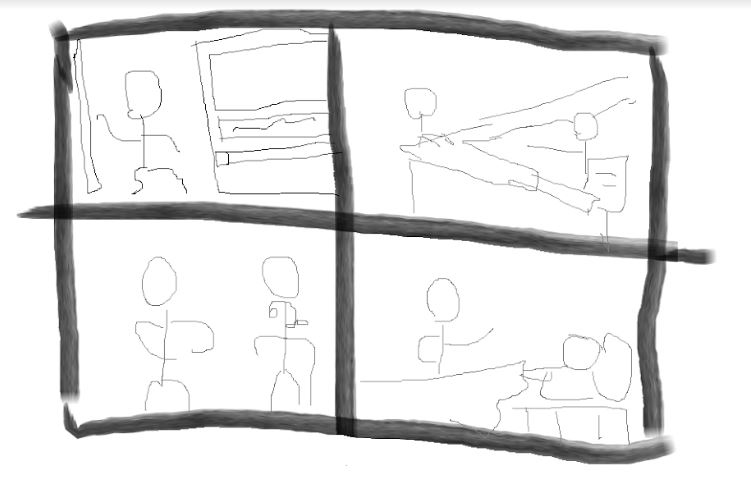
With all of the control in the world of art, there is sometimes a lack of alternate art— in fact it is almost always deleted from normal discourse. However, occasionally a work is so striking that it must be discussed. Fim Tuckley’s Four Panels is such a work. To even begin an analysis, Four Panels must be broken into its constituent sections, divided so boldly by almost childlike brushstrokes.
The first panel implies action — the waving arm of the stick-man obviously alluding to the high sculpture of the used-car lot: the wacky waving inflatable tube-arm man. The contrast between the closed and open doors emphasizes the confusion and indecision in the situation, something only highlighted by the stick-man’s lack of face — is he happy? Scared? Aroused? The viewer, to solve the mystery, must continue looking.
In the second panel, there is masterful use of the hierarchy of scale. The figure from the first panel, the clear centre of the work, stands proud over a pointing figure at a desk. Tuckley’s ability to show athleticism is nothing short of spectacular, and not much more can be said. The arm masterfully guides the reader back to the left, and towards the second row.
The bottom-left panel continues to showcase the artist’s clear mastery of figure. On the left is our hero— dynamic, active, macho— depicted in the aggressive posture known as ‘REEEEEEE.’ To the right, however, is an enigma: another figure, leaning to the right. But ah! The viewer notices the device around the figures neck! Is it, perhaps, a phallus? Or, wait, a stethoscope? Both! Suddenly, the subject and action of the work is revealed — the stethoscope showing our hero is in a hospital, and the sagging phallus giving the reason of his presence: a failure of his virility!
In the final scene, these elements are brought to a heady conclusion. Our protagonist frantically waves to a reclining figure on what appears to be either several misshapen potatoes, implying failed growth, or a hospital bed. The raw emotional energy of this scene cannot be understated. Indeed, like the romantic masterpiece The Room, this final panel tears both the protagonist and the viewer apart.
Four panels is perhaps one of the great works of the minute. But analysis of this image only dilutes its raw power. For the viewer, there is only a single question that needs to be asked— is this Loss?



